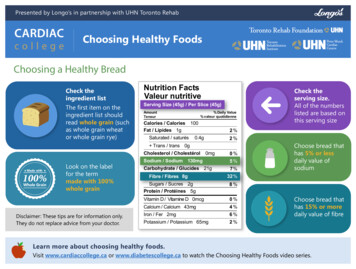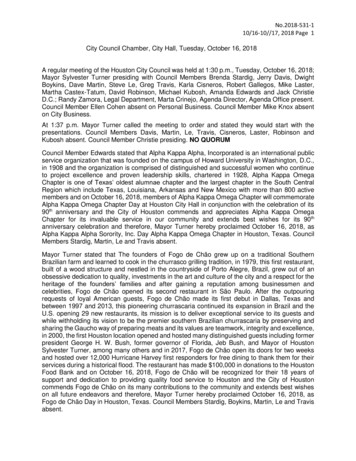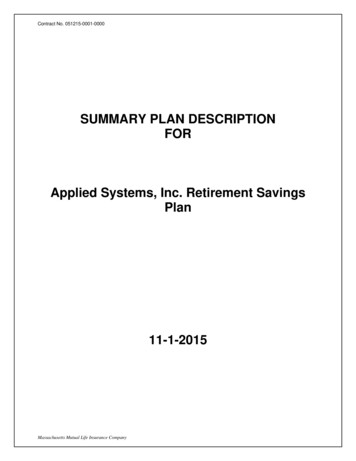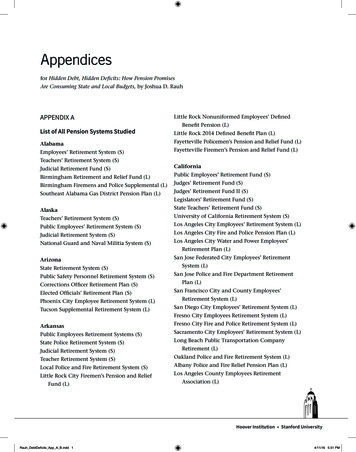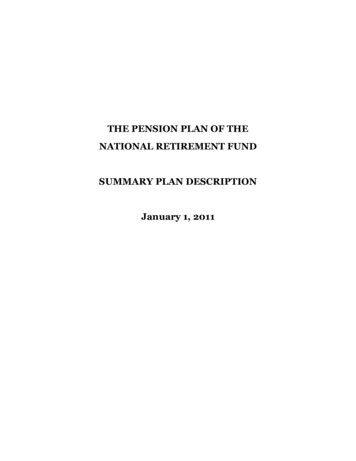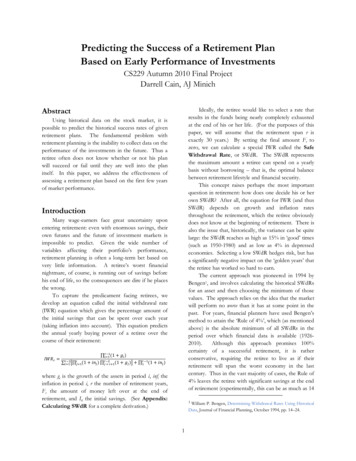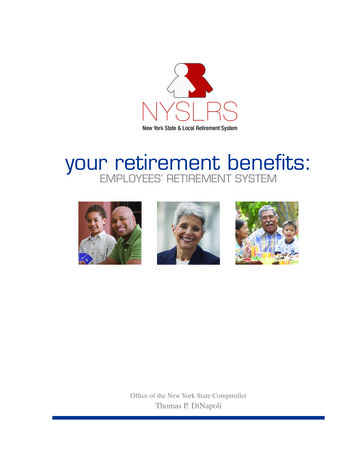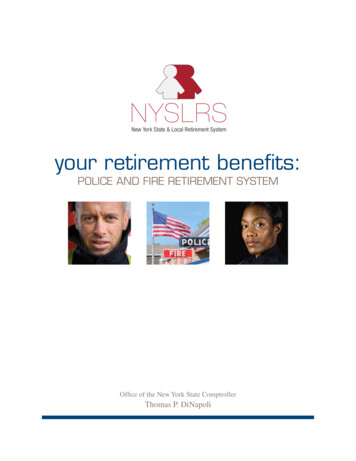
Transcription
CHOOSING ARETIREMENT SOLUTIONFOR YOUR SMALL BUSINESS
Choosing a Retirement Solution for Your Small Business is a joint project of the U.S. Department of Labor’sEmployee Benefits Security Administration (EBSA) and the Internal Revenue Service.To view this and other EBSA publications, visit the agency’s website.To order publications or speak with a benefits advisor, contact EBSA electronically.Or call toll free: 866–444–3272This material will be made available in alternative formatto persons with disabilities upon request:Voice phone: (202) 693–8664TTY: (202) 501–3911This booklet constitutes a small entity compliance guide for purposes of the Small BusinessRegulatory Enforcement Fairness Act of 1996. It does not constitute legal, accounting, or otherprofessional advice.
Starting a retirement savings plan can be easierthan most business owners think. What’s more,there are many retirement programs that providetax advantages to both employers and employees.Why Save?Experts estimate that Americans will need 70 to 90percent of their preretirement income to maintain theircurrent standard of living when they stop working. Nowis the time for you and your employees to start planningfor retirement. As an employer, you have an importantrole in helping America’s workers save.By starting a retirement savings plan, you will help youremployees save for their future. Retirement plans mayalso help you attract and retain qualified employees, andthey offer tax savings to your business. You will helpsecure your own retirement as well. You can establish aplan even if you are self-employed.Any Tax Advantages?A retirement plan has significant tax advantages: Employer contributions are deductible from theemployer’s income, Employee contributions (other than Rothcontributions) are not taxed until distributed to theemployee, Money in the plan grows tax-free, and Distributions may be eligible for tax-favoredrollovers or transfers into other retirement programs.Any Other Incentives?It’s easy to establish a retirement plan that benefitsyou, your business and your employees, and there areadditional incentives for having a plan: High contribution limits so you and your employeescan set aside large amounts for retirement; “Catch-up” rules that allow employees age 50 andover to set aside additional contributions. The “catchup” amount varies, depending on the type of plan; A tax credit for small employers that enables them toclaim a credit for part of the ordinary and necessarycosts of starting a SEP, SIMPLE, or certain othertypes of retirement plans (more on these later). Thecredit equals 50 percent of the cost to set up andadminister the plan, up to a maximum of 500 peryear for each of the first 3 years of the plan; A tax credit for certain low- and moderate-incomeindividuals (including self-employed) who makecontributions to their plans (“Saver’s Credit”). Theamount of the credit is based on the contributionsparticipants make and their credit rate. Themaximum contribution eligible for the creditis 2,000. The credit rate can be as low as 10percent or as high as 50 percent, depending on theparticipant’s adjusted gross income; and A Roth program that can be added to a 401(k) planto allow participants to make after-tax contributionsinto separate accounts, providing an additional wayto save for retirement. Distributions upon deathor disability or after age 59 1/2 from Roth accountsheld for 5 years, including earnings, are generallytax-free.A Few Retirement FactsMost private-sector retirement vehicles are eitherIndividual Retirement Arrangements (IRAs), definedcontribution plans, or defined benefit plans.People tend to think of an IRA as something thatindividuals establish on their own, but an employercan help its employees set up and fund their IRAs.With an IRA, the amount that an individual receives atretirement depends on the funding of the IRA and theearnings (or losses) on those funds.Defined contribution plans are employer-establishedplans that do not promise a specific benefit atretirement. Instead, employees or their employer (orboth) contribute to employees’ individual accountsunder the plan, sometimes at a set rate (such as 5percent of salary annually). At retirement, an employeereceives the accumulated contributions plus earnings(or minus losses) on the invested contributions.Defined benefit plans, on the other hand, promise aspecified benefit at retirement, for example, 1,000a month. The amount of the benefit is often based ona set percentage of pay multiplied by the number ofyears the employee worked for the employer offeringthe plan. Employer contributions must be sufficient tofund promised benefits.Small businesses may choose to offer IRAs, definedcontribution plans, or defined benefit plans. Manyfinancial institutions and retirement plan practitionersmake available one or more of these retirement plansthat have been pre-approved by the IRS.On the following two pages you will find a chartoutlining the advantages of each of the most populartypes of IRA-based and defined contribution plans andan overview of a defined benefit plan.
IRA-BASED PLANSPayrollDeduction IRASEPProfit SharingSafe Harbor 401(k)Automatic Enrollment401(k)Traditional 401(k)Easy to set up and maintain.Salary reduction plan with littleadministrative paperwork.Permits employer to make largecontributions for employees.Permits high level of salary deferralsby employees without annualnondiscrimination testing.Provides high level of participation andpermits high level of salary deferrals byemployees. Affords safe harbor relief fordefault investments.Permits high level of salary deferrals byemployees.Provides a fixed, pre-establishedbenefit for employees.EmployerEligibilityAny employer with one or moreemployees.Any employer with one ormore employees.Any employer with 100 orfewer employees that doesnot currently maintain anotherretirement plan.Any employer with one or moreemployees.Any employer with one or moreemployees.Any employer with one or moreemployees.Any employer with one or moreemployees.Any employer with one or moreemployees.Employer’sRoleArrange for employees to makepayroll deduction contributions.Transmit contributions foremployees to IRA. No annualfiling requirement for employer.May use IRS Form 5305SEP to set up the plan. Noannual filing requirement foremployer.May use IRS Form 5304-SIMPLEor 5305-SIMPLE to set upthe plan. No annual filingrequirement for employer. Bankor financial institution handlesmost of the paperwork.No model form to establish thisplan. May need advice from afinancial institution or employeebenefit adviser. Must file annualForm 5500.No model form to establish this plan.May need advice from a financialinstitution or employee benefitadviser. A minimum amount ofemployer contributions is required.Must file annual Form 5500.No model form to establish this plan.May need advice from a financialinstitution or employee benefit adviser.May require annual nondiscriminationtesting to ensure that plan doesnot discriminate in favor of highlycompensated employees. Must file annualForm 5500.No model form to establish this plan.May need advice from a financialinstitution or employee benefit adviser.Requires annual nondiscriminationtesting to ensure that plan doesnot discriminate in favor of highlycompensated employees. Must file annualForm 5500.No model form to establish this plan.Advice from a financial institutionor employee benefit adviser wouldbe necessary. Must file annual Form5500. An actuary must determineannual contributions.ContributorsTo The PlanEmployee contributions remitted through payroll deduction.Employer contributions only.Employee salary reductioncontributions and employercontributions.Annual employer contribution isdiscretionary.Employee salary reduction contributions and employer contributions.Employee salary reduction contributionsand maybe employer contributions.Employee salary reduction contributionsand maybe employer contributions.Primarily funded by employer.MaximumAnnualContribution(perparticipant) 6,000 for 2021 and for 2022.Participants age 50 or over canmake additional contributionsup to 1,000.Up to 25% of compensation1but no more than 58,000 for2021 and 61,000 for 2022.Employee: 13,500 in 2021 and 14,000 in 2022. Participantsage 50 or over can makeadditional contributions up to 3,000 in 2021 and in 2022.Up to the lesser of 100% ofcompensation1 or 58,000 for2021 and 61,000 for 2022.Employer can deduct amounts thatdo not exceed 25% of aggregatecompensation for all participants.Employee: 19,500 in 2021 and 20,500 in 2022. Participants age50 or over can make additionalcontributions up to 6,500 in 2021and in 2022.Employee: 19,500 in 2021 and 20,500in 2022. Participants age 50 or overcan make additional contributions up to 6,500 in 2021 and in 2022.Employee: 19,500 in 2021 and 20,500in 2022. Participants age 50 or overcan make additional contributions up to 6,500 in 2021 and in 2022.Annually determined contribution.Employer/Employee Combined: Upto the lesser of 100% of compensation1or 58,000 for 2021 and 61,000 for2022. Employer can deduct (1) amountsthat do not exceed 25% of aggregatecompensation for all participants and (2)all salary reduction contributions.Employer/Employee Combined: Up tothe lesser of 100% of compensation1 or 58,000 for 2021 and 61,000 for 2022.Employer can deduct (1) amounts thatdo not exceed 25% of aggregatecompensation for all participants and(2) all salary reduction contributions.Employer: Either matchemployee contributions 100% offirst 3% of compensation (canbe reduced to as low as 1% inany 2 out of 5 yrs.); or contribute2% of each eligible employee’scompensation.2See the IRS’swebsite forannual geRequirementsWithdrawals,Loans &PaymentsVesting2SIMPLE IRA PlanDEFINED BENEFITPLANSEasy to set up and maintain.KeyAdvantage1DEFINED CONTRIBUTION PLANSEmployer/Employee Combined:Up to the lesser of 100% ofcompensation1 or 58,000 for 2021and 61,000 for 2022. Employercan deduct (1) amounts that donot exceed 25% of aggregatecompensation for all participants and(2) all salary reduction contributions.Employer can decide whetherto make contributions year-toyear.Employee can decide how muchto contribute. Employer mustmake matching contributionsor contribute 2% of eachemployee’s compensation.Employer makes contribution asset by plan terms.Employee can decide how muchto contribute based on a salaryreduction agreement. The employermust make either specified matchingcontributions or a 3% contribution toall participants.Employees, unless they opt otherwise,must make salary reduction contributionsspecified by the employer. The employercan make additional contributions,including matching contributions as setby plan terms.Employee can decide how much tocontribute based on a salary reductionagreement. The employer can makeadditional contributions, includingmatching contributions as set by planterms.Employer generally required to makecontribution as set by plan terms.There is no requirement. Can be Must be offered to allmade available to any employee. employees who are at least 21years old, employed by theemployer for 3 of the last 5years and had compensation of 650 for 2021 and for 2022.Must be offered to all employeeswho have compensation of atleast 5,000 in any prior 2 years,and are reasonably expectedto earn at least 5,000 in thecurrent year.Generally, must be offered to allemployees at least 21 years oldwho worked at least 1,000 hours ina previous year.Generally, must be offered to allemployees at least 21 years old whoworked at least 1,000 hours in aprevious year.Generally, must be offered to allemployees at least 21 years old whoworked at least 1,000 hours in a previousyear.Generally, must be offered to allemployees at least 21 years old whoworked at least 1,000 hours in a previousyear.Generally, must be offered to allemployees at least 21 years old whoworked at least 1,000 hours in aprevious year.Employee can decide how muchto contribute at any time.Withdrawals permitted anytimesubject to federal income taxes;early withdrawals subject toan additional tax (special rulesapply to Roth IRAs). Participantloans are not permitted.Withdrawals permitted anytimesubject to federal income taxes;early withdrawals subject toan additional tax. Participantscannot take loans from theirSEP–IRAs.Withdrawals permitted anytimesubject to federal income taxes;early withdrawals subject toan additional tax. Participantscannot take loans from theirSIMPLE IRAs.Withdrawals permitted after aspecified event occurs (retirement,plan termination, etc.) subjectto federal income taxes. Planmay permit loans and hardshipwithdrawals; early withdrawalssubject to an additional tax.Withdrawals permitted after aspecified event occurs (retirement,plan termination, etc.) subjectto federal income taxes. Planmay permit loans and hardshipwithdrawals; early withdrawalssubject to an additional tax.Withdrawals permitted after a specifiedevent occurs (retirement, plantermination, etc.) subject to federalincome taxes. Plan may permit loans andhardship withdrawals; early withdrawalssubject to an additional tax.Withdrawals permitted after a specifiedevent occurs (retirement, plantermination, etc.) subject to federalincome taxes. Plan may permit loans andhardship withdrawals; early withdrawalssubject to an additional tax.Payment of benefits after aspecified event occurs (retirement,plan termination, etc.). Plan maypermit loans; early withdrawalssubject to an additional tax.Contributions are immediately100% vested.Contributions are immediately100% vested.All contributions areimmediately 100% vested.May vest over time according toplan terms.Employee salary reductioncontributions and all safe harboremployer contributions areimmediately 100% vested. Someemployer contributions may vest overtime according to plan terms.Employee salary reduction contributionsare immediately 100% vested. Employercontributions may vest over timeaccording to plan terms.Employee salary reduction contributionsare immediately 100% vested. Employercontributions may vest over timeaccording to plan terms.May vest over time according to planterms.Maximum compensation on which contributions can be based is 290,000 for 2021 and 305,000 for 2022.Maximum compensation on which employer 2% contributions can be based is 290,000 for 2021 and 305,000 for 2022.
Payroll Deduction IRAsEven if an employer doesn’t want to adopt a retirementplan, the employer can allow its employees to contributeto an IRA through payroll deductions, providing a simpleand direct way for employees to save. In this type ofarrangement, the employee always makes the decisionsabout whether, when, and how much to contribute to theIRA (up to 6,000 for 2021 and for 2022, and 7,000 for2021 and for 2022 if age 50 or older, increasing thereafter).Some individuals eligible to contribute to an IRA waituntil the end of the year to set aside the money andthen find that they don’t have sufficient funds to do so.Payroll deductions allow employees to plan ahead andsave smaller amounts each pay period. Payroll deductioncontributions are tax-deductible by the employee, to thesame extent as other IRA contributions.Simplified Employee Pensions (SEPs)A SEP plan allows employers to set up SEP IRAs forthemselves and each of their employees. Employersgenerally must contribute a uniform percentage of payfor each employee, although they do not have to makecontributions every year. Employer contributions arelimited to the lesser of 25 percent of pay or 58,000 for2021 and 61,000 for 2022. (Note: the dollar amount isindexed for inflation and may increase.) Most employers,including those who are self-employed, can establish a SEP.SEPs have low start-up and operating costs and can beestablished using a two-page form (Form 5305-SEP). Andyou can decide how much to put into a SEP each year –offering you some flexibility when business conditions vary.SIMPLE IRA PlansA SIMPLE IRA plan is a savings option for employerswith 100 or fewer employees.This plan allows employees to contribute a percentageof their salary each paycheck and requires employercontributions. Under SIMPLE IRA plans, employeescan set aside up to 13,500 in 2021 and 14,000 in 2022( 16,500 in 2021 and 17,000 in 2022 if age 50 or older)by payroll deduction (subject to cost-of-living adjustmentsin later years). Employers must either match employeecontributions dollar for dollar – up to 3 percent of anemployee’s compensation – or make a fixed contributionof 2 percent of compensation for all eligible employees,even if the employees choose not to contribute.If your plan provides for it, you can choose toautomatically enroll employees in SIMPLE IRA plans aslong as the employees are allowed to choose not to havesalary reduction contributions made to their SIMPLEIRAs or to have salary reduction contributions made in adifferent amount.SIMPLE IRA plans are easy to set up. You fill out a shortform to establish a plan and ensure that SIMPLE IRAs (tohold contributions made under the SIMPLE IRA plan) areestablished for each employee. A financial institution cando much of the paperwork. Additionally, administrativecosts are low.You may have your employees set up their own SIMPLE IRAsat a financial institution of their choice or have all SIMPLEIRAs maintained at one financial institution you choose.Employees can decide how and where the money will beinvested, and keep their SIMPLE IRAs even when theychange jobs.Profit Sharing PlansEmployer contributions to a profit sharing plan can bediscretionary. Depending on the plan terms, there is often noset amount that an employer needs to contribute each year.If you do make contributions, you will need to havea set formula for determining how the contributionsare allocated among plan participants. The funds areaccounted separately for each employee.Profit sharing plans can vary greatly in their complexity.Many financial institutions offer prototype profit sharingplans that can reduce the administrative burden onindividual employers.401(k) Plans401(k) plans have become a widely accepted retirementsavings vehicle for small businesses. An estimated 60million U.S. workers participate in 401(k) plans that havetotal assets of about 6.9 trillion.With a 401(k) plan, employees can choose to defera portion of their salary. So instead of receiving thatamount in their paycheck today, the employees cancontribute the amount into a 401(k) plan sponsored bytheir employer. These deferrals are accounted separatelyfor each employee. Deferrals are made on a pretax basisbut, if the plan allows, the employee can choose to makethem on an after-tax (Roth) basis. Many 401(k) plansprovide for employer matching or other contributions.The Federal Government and most state governments donot tax employer contributions and pretax deferrals (plusearnings) until distributed.Like most profit sharing plans, 401(k) plans can varysignificantly in their complexity. However, many financialinstitutions and other organizations offer IRS pre-approved401(k) plans, which can greatly lessen the administrativeburden of establishing and maintaining these plans.Safe Harbor 401(k) PlansA safe harbor 401(k) plan is intended to encourage planparticipation among rank-and-file employees and toease the administrative burden by eliminating the testsordinarily applied under a traditional 401(k) plan. Thisplan is ideal for businesses with highly compensatedemployees whose contributions would be limited in atraditional 401(k) plan.
A safe harbor 401(k) plan allows employees to contribute apercentage of their salary each paycheck and requires employercontributions. In a safe harbor 401(k) plan, the mandatoryemployer contribution is always 100 percent vested.Automatic Enrollment 401(k) PlansAutomatic enrollment 401(k) plans can increase planparticipation among rank-and-file employees and makeit more likely that the plan will pass the tests ordinarilyrequired under a traditional 401(k) plan. Some automaticenrollment 401(k) plans are exempt from the testing.This type of plan is for employers who want a high levelof participation, and who have highly compensatedemployees whose contributions might be limited under atraditional 401(k) plan.Employees are automatically enrolled in the plan andcontributions are deducted from their paychecks, unlessthey opt out of contributing after receiving notice from theplan. There are default employee contribution rates, whichmay rise incrementally over the first few years, althoughthe employee can choose different amounts.Employer Association and ProfessionalEmployer Organization Retirement Plansemployers obtain economies of scale for administrativecosts and investment choices currently enjoyed by largebusinesses. The employer association or PEO can act asplan administrator and assume many of the responsibilitiesof operating the plan, allowing you to keep more of yourday-to-day focus on managing your business.Pooled Employer PlansPooled employer plans provide a way for unrelatedemployers with no common interest or otherorganizational relationship to participate in a multipleemployer defined contribution retirement plan, such asa 401(k), and offer a retirement savings option to theiremployees. A pooled employer plan allows many of theadministrative and fiduciary responsibilities of sponsoringa retirement plan to be transferred to a pooled planprovider. Similar to employer association and PEO plans,a well run pooled employer plan can offer employers,especially small employers, a workplace retirementsavings option with reduced burdens and costs comparedto sponsoring their own separate retirement plan.Defined Benefit PlansYou can join with other employers in your geographic areaor industry as an employer group or association to offer adefined contribution retirement plan, such as a 401(k), toyour employees. Also, if you use a professional employerorganization (PEO) as part of your business, your PEOmay sponsor a defined contribution plan that you can offerto your employees. A well run employer association orPEO multiple employer plan can help groups of smallSome employers find that defined benefit plans offerbusiness advantages. For instance, businesses cangenerally contribute (and therefore deduct) more eachyear than in defined contribution plans. In addition,employees often value the fixed benefit provided by thistype of plan and can often receive a greater benefit atretirement than under any other type of retirement plan.However, defined benefit plans are often more complexand, likely, more expensive to establish and maintain thanother types of plans.To Find Out More Also available from the U.S. Department of Labor:The following jointly developed publications are availablefor small businesses on the DOL and IRS websites andthrough DOL’s toll-free number listed below: 401(k) Plans for Small Businesses(Publication 4222) Automatic Enrollment 401(k) Plans for SmallBusinesses (Publication 4674) Payroll Deduction IRAs for Small Businesses(Publication 4587) Profit Sharing Plans for Small Businesses(Publication 4806) SEP Retirement Plans for Small Businesses(Publication 4333) SIMPLE IRA Plans for Small Businesses(Publication 4334)For business owners with a plan: Adding Automatic Enrollment to Your 401(k)Plan (Publication 4721) Retirement Plan Correction Programs(Publication 4224)DOL websitePublications request number: 866-444-3272IRS websiteDOL sponsors an interactive website – the Smallthat encouragessmall business owners to choose theappropriate retirement plan for their business andprovides resources on maintaining plans.Business Retirement Savings Advisor –Publications for small businesses: Meeting Your Fiduciary Responsibilities Understanding Retirement Plan Fees and Expenses Selecting an Auditor for Your Employee Benefit Plan Selecting and Monitoring Pension Consultants – Tips forPlan Fiduciaries Tips for Selecting and Monitoring Service Providers forYour Employee Benefit PlanAlso available from the Internal Revenue Service: Retirement Plans for Small Business (SEP, SIMPLE, andQualified Plans) (Publication 560) Contributions to Individual Retirement Arrangements(IRAs) (Publication 590-A) Distributions from Individual Retirement Arrangements(IRAs) (Publication 590-B) Designated Roth Accounts Under 401(k), 403(b), orGovernmental 457(b) Plans (Publication 4530)
EMPLOYEE BENEFITS SECURITY ADMINISTRATIONUNITED STATES DEPARTMENT OF LABORPublication 3998 (Rev. 11-2021) Catalog Number 34066SDepartment of the Treasury Internal Revenue Service www.IRS.govNovember 2021
contribution plans, or defined benefit plans. Many financial institutions and retirement plan practitioners make available one or more of these retirement plans that have been pre-approved by the IRS. On the following two pages you will find a chart . outlining the advantages of each of the most popular an overview of a defined benefit plan.
